Passenger Lift For Construction Site: A Comprehensive Guide
Discover the ultimate guide to passenger lift for construction site, exploring key insights and solutions. Elevate your projects now!

Muneer Ahammed | Updated on September 24, 2023
Construction sites require efficient and safe transportation of workers, materials, and equipment to different levels of the building. This is where passenger lifts come into play, providing a quick and convenient solution for vertical transportation.
In this blog, we will discuss the use of passenger lift for construction site, the different types available, and the factors to consider when choosing the right one for your project.
Introduction To Passenger Lift for Construction Site
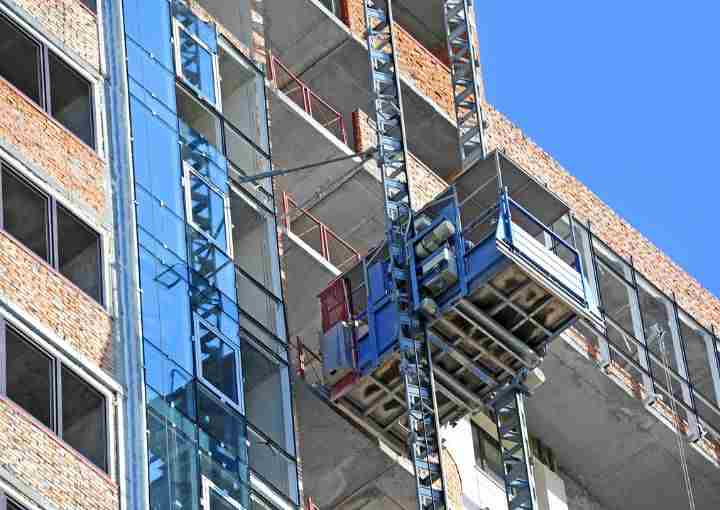
Passenger lifts, also known as construction elevators, are an essential component of construction sites, especially for high-rise buildings. They play a crucial role in the safe and efficient transport of personnel, tools, and materials between different levels of a building under construction. The following are some of the key benefits that passenger lifts bring to construction sites:
1. Improved Safety: Passenger lifts provide a safe and secure means of transportation for workers, reducing the risk of accidents and injuries from climbing stairs or using ladders.
2. Increased Productivity: By allowing workers to quickly and easily move between levels, passenger lifts increase the efficiency and speed of construction work, reducing the overall time and cost of a project.
3. Enhanced Accessibility: Passenger lifts provide easy access to all levels of a building, even in challenging or hard-to-reach locations, allowing workers to perform their duties more efficiently.
4. Reduced Physical Strain: Carrying heavy tools and materials up and down stairs can put significant strain on workers, but passenger lifts reduce this strain, improving the overall health and safety of construction personnel.
5. Improved Material Management: Passenger lifts can also be used to transport materials, tools, and equipment between levels, reducing the need for manual handling and improving material management on site.
Factors to Consider When Choosing a Material Lift for a Construction Site
There are several important factors to consider when choosing a passenger lift for construction site, including
Load capacity and size:
It is essential to choose a lift with the right load capacity to meet your transportation needs. You also need to consider the size of the lift, taking into account the size of the cabin and the height of the lift.
Speed and performance:
The speed of the lift and its performance is a crucial factor to consider, especially for time-sensitive construction projects.
Safety features of construction site lifts:
Ensuring safety must remain the foremost concern at construction sites. When choosing a passenger lift, look for models with advanced safety features such as emergency stop buttons, anti-skid flooring, and automatic overspeed protection.
Brand and model: Consider the brand and model of the passenger lift, taking into account the manufacturer’s reputation, product quality, and after-sales support.
Weather and environment resistance: Construction sites can be exposed to harsh weather conditions, so it is important to choose a lift that is resistant to extreme weather conditions.
Temporary or permanent installation: Decide whether you need a temporary or permanent lift installation, as this will affect the type of lift you choose.
Power supply and energy efficiency: Consider the power supply and energy efficiency of the lift, as this will affect its operating cost.
Noise and vibration level: Noise and vibration level is an important consideration, especially if the construction site is located in a residential area.
Additional features such as cabins, doors, and control systems: Look for additional features such as cabins, doors, and control systems that meet your specific requirements.
Types of Passenger Lift for Construction Site
There are different types of passenger elevators that are used for construction sites. Let’s have a look at a few of them.
Mast-climbing passenger lifts:
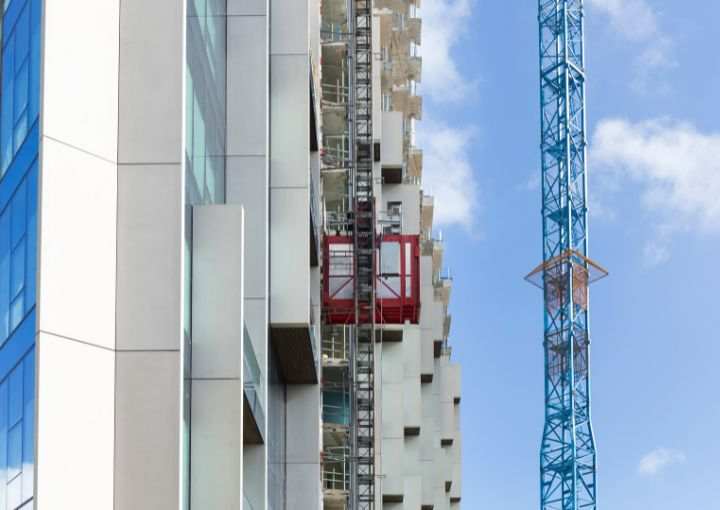
These lifts are designed to be installed on a mast, providing a quick and efficient solution for vertical transportation.
Electric traction passenger lift
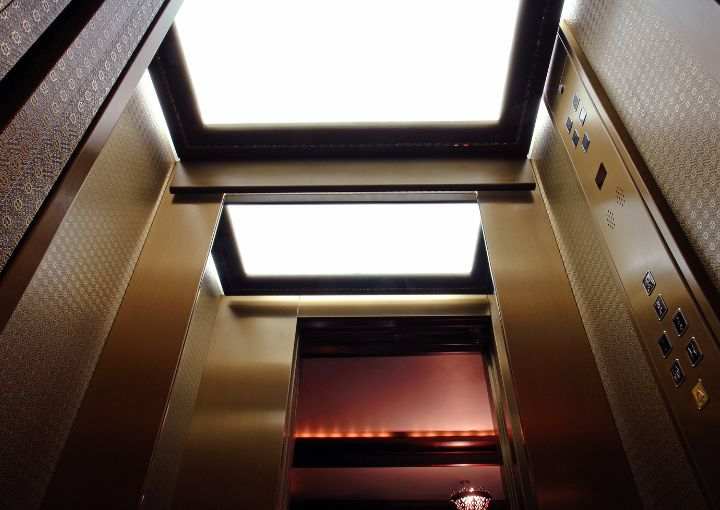
An Electric Traction Passenger Lift uses an electric motor to pull a cable attached to the lift car and is used to transport people and equipment between different levels of the construction site.
MRL passenger lift
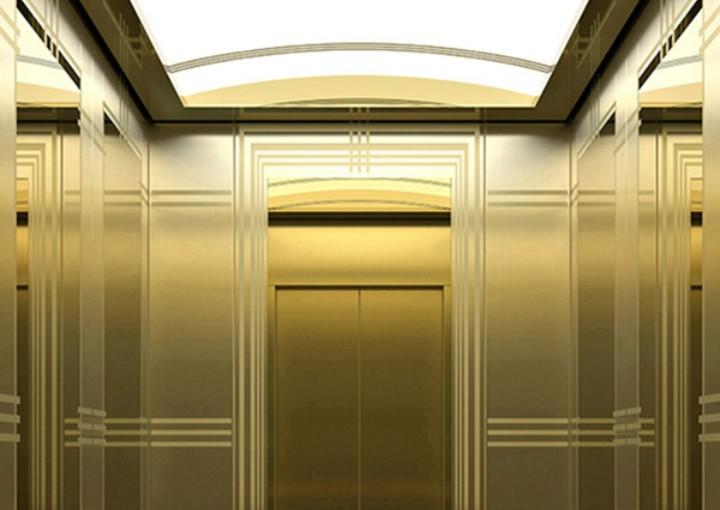
MRL (Machine Room-Less) Passenger Lift is a type of electric traction lift where the machinery is located in the lift shaft, eliminating the need for a separate machine room. It is ideal for construction sites where space is limited and where a separate machine room is not feasible.
Hydraulic passenger lift
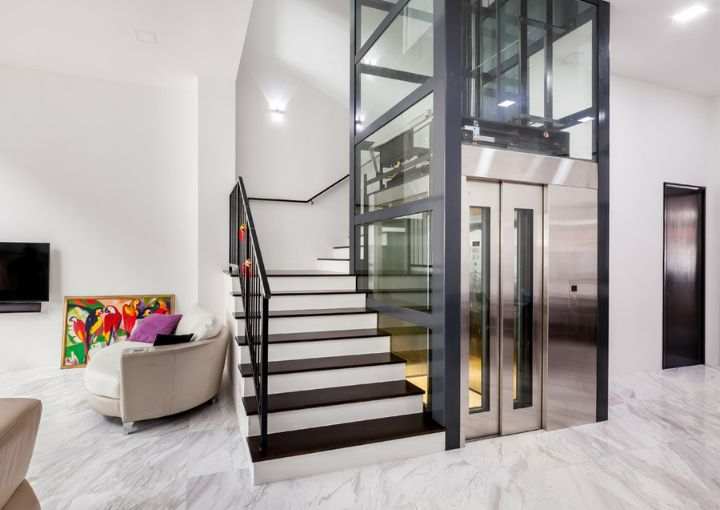
Hydraulic Passenger Lift uses a hydraulic piston to raise and lower the lift car. It is used when the height of the construction site is not very high or when there is limited space for a machine room.
Tower passenger lifts:
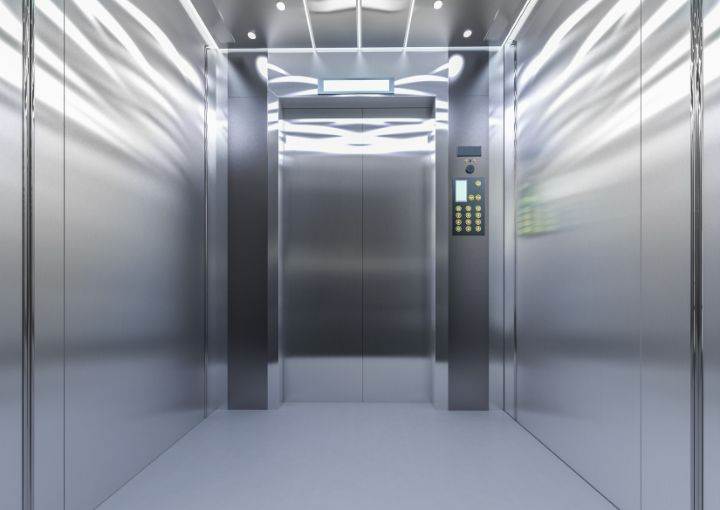
Tower passenger lifts are a type of mast-climbing lift but with the added advantage of a tower structure that provides stability and support.
Scaffold passenger lifts:
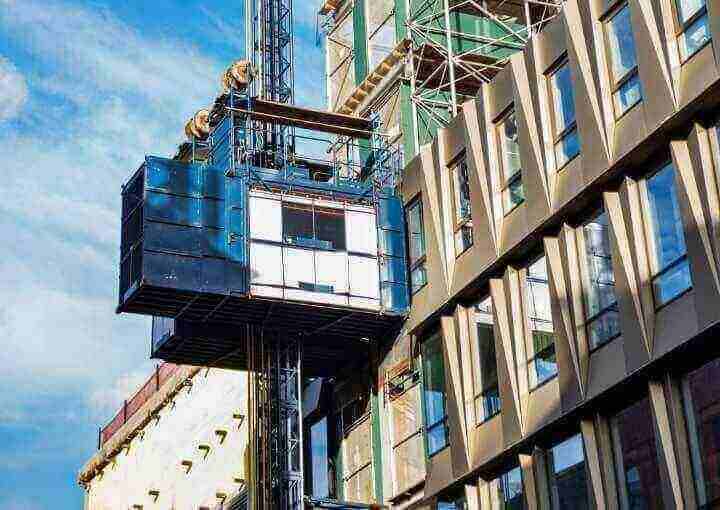
Scaffold passenger lifts are designed to be installed on scaffolding, providing a convenient solution for vertical transportation.
Trailer-mounted passenger lifts:
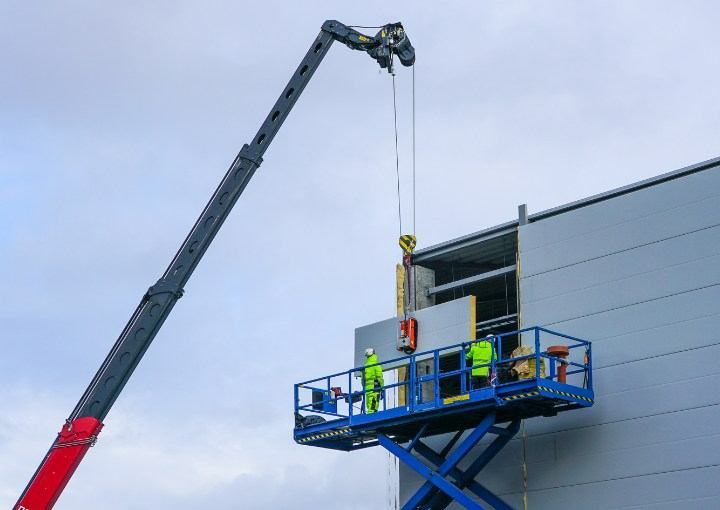
Trailer-mounted passenger lifts are a versatile and portable option, allowing for easy transportation from one location to another.
Passenger and material hoist
A passenger hoist, also known as a personnel hoist or a passenger material hoist lift, is a type of lift designed to transport people and goods vertically within a building or structure.
It consists of a lift car attached to a hoisting mechanism that is powered by an electric motor or hydraulic system.
Passenger hoists are commonly used in construction sites, multi-story buildings, and industrial facilities to move people and materials between different levels. Passenger hoist specification depends on its size and capacity and has various safety features to ensure their safe operation.
Cost and Maintenance
The passenger lift price for construction sites can vary widely, depending on the type of lift, its size, and the additional features. Maintenance and repair costs should also be considered, as regular maintenance is essential to ensure the lift’s longevity and reliability. There are also cost-saving measures and financing options available to help make the purchase of a passenger lift more affordable.
Safety and regulations
The use of passenger lifts also involves risks, and it’s important to follow safety regulations to minimize the likelihood of accidents or other incidents.
OSHA and Other Industry Standards
The Occupational Safety and Health Administration (OSHA) sets standards for the safe use of passenger lift for construction site. OSHA’s regulations cover a wide range of topics, from the design and construction of passenger lifts to the training of lift operators. Some of the key OSHA standards for passenger lifts include
1. The lift must be designed and built to prevent tipping over, collapsing, or striking workers or objects.
2. The lift must be equipped with appropriate guardrails, fall protection systems, and other safety features.
3. The lift must be operated only by trained and competent personnel.
4. Regular maintenance and inspections must be performed to ensure the lift remains in good working condition.
In addition to OSHA regulations, there are also industry standards set by organizations like the American National Standards Institute (ANSI) and the Scaffold Industry Association (SIA). These standards provide additional guidance on the safe use of passenger lifts, and construction sites are encouraged to follow these standards as well.
Emergency Procedures and Safety Devices
In the event of an emergency, construction sites must establish procedures in place to ensure the safe evacuation of workers and equipment from the passenger lift. Some common safety devices include:
1. Emergency stop buttons can be used to quickly shut down the lift in case of an emergency.
2. Alarms that sound in case of a malfunction or other emergency.
3. Emergency lighting to help workers evacuate the lift in case of a power outage.
It’s also important for construction sites to train workers on emergency procedures, including how to safely evacuate the lift and how to use emergency safety devices. This training should be provided on an ongoing basis to reinforce the importance of emergency procedures and to ensure that workers are prepared to act in case of an emergency
Installation and Commissioning of Passenger Lift for Construction Site
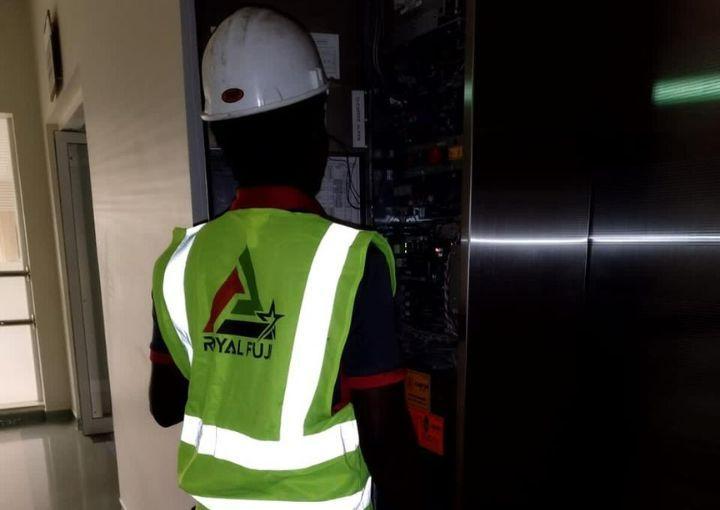
The installation and commissioning of passenger lift for construction site requires careful planning, preparation, and attention to detail.
Site Preparation and Planning
Before the installation of a passenger lift, the site must be prepared to ensure the lift can be safely and effectively installed. This includes clearing any obstacles and ensuring the site is level and stable. Additionally, the electrical and plumbing systems must be installed, and the lift pit and headroom must be prepared.
Installation Process
The passenger lift installation involves a team of professionals who will place the lift and all its components in position. They will then connect the electrical and plumbing systems, install the doors and cabins, and carry out any necessary testing to ensure the lift is working correctly.
Testing and Commissioning
Once the installation is complete, the lift must be thoroughly tested to ensure it meets all industry standards and passenger lift regulations. This includes conducting load tests, speed tests, and safety tests. After the lift has passed all tests, it will be commissioned and ready for use.
Operation and Maintenance
The operation and maintenance of a passenger lift for construction site is crucial to ensuring its longevity and safety. This includes performing regular maintenance checks, cleaning and lubricating the lift, and inspecting the lift for any signs of wear or damage. In the event of any issues, a trained maintenance technician should be called to repair the lift.
Daily Operation and Maintenance
To ensure the smooth operation of the lift, daily checks should be performed to make sure the lift is working correctly and to identify any issues before they become serious. This includes checking the lift’s power supply, brakes, and doors, as well as checking for any signs of wear or damage.
Training for Operators and Maintenance Personnel
It is essential that operators and maintenance personnel receive the appropriate training to ensure they can operate and maintain the lift safely and efficiently. This includes training on the lift’s operation, maintenance procedures, and emergency procedures.
Record Keeping and Documentation
It is important to keep records and documentation of the lift’s maintenance and operation, including any repairs, tests, or inspections. This helps to ensure the lift is in good working order and helps to identify any potential issues before they become serious.
Common Issues and Troubleshooting
Despite the best planning and maintenance, issues with passenger lifts can occur. Some common problems include power supply issues, door problems, and brake failures. Regular maintenance checks and prompt repairs can help to minimize these issues and prevent more serious problems from developing.
Advancements and Innovation
The passenger lift industry continues to advance and innovate, with new technologies and features being introduced all the time. These advancements include improved safety features, increased energy efficiency, and automation, all of which help to make passenger lifts more reliable and user-friendly.
Conclusion
Passenger lifts play a crucial role in construction sites by providing workers with safe and efficient access to the work areas.
There are several factors to consider when choosing the right passenger lift for a construction site, including load capacity and size, speed, and performance, safety features, brand and model, different types of passenger lifts available for construction sites, the cost, and other industry standards play a significant role in ensuring the safety and reliability of passenger lifts, and regular inspections and maintenance are essential.
As a leading supplier of Passenger Lift for Construction Site Royal Fuji specializes in supplying, installing, and maintenance of passenger lifts specifically designed for construction sites. We offer a wide range of lift solutions that cater to the unique needs of construction sites.
Royal Fuji will be the right passenger lift to ensure that the lift you choose is the best fit for your specific needs and provides the safety, performance, and efficiency necessary for a successful project.
Our products and services aim to make construction work easier, safer, and more efficient. They offer a variety of lift types for this cause.
Choosing the right Passenger Lift for a Construction Sites company is important as it ensures the lift is safe, efficient, and meets the specific needs of the construction site. As a trusted elevator company in the industry for years, we provide you with the best of our services.
Frequently Asked Questions
1. What is the maximum height a passenger lift for a construction site can reach?
The maximum height a passenger lift for a construction site can reach can vary depending on the model but typically ranges from 100 to 500 feet or more.
2. What is the weight capacity of a passenger lift for a construction site?
The weight capacity of a passenger lift for a construction site can vary depending on the model but typically ranges from 1000 to 5000 pounds.
3. What is the minimum pit depth required for a passenger lift for a construction site?
The necessary pit depth for a construction site’s passenger lift may fluctuate based on lift type and manufacturer guidelines, typically spanning 2 to 4 feet.
4. What is the minimum overhead clearance required for a passenger lift for a construction site?
The minimum overhead clearance required for a passenger lift for a construction site can vary depending on the type of lift and the manufacturer’s specifications but typically ranges from 15 to 20 feet.
5. What is the power requirement for a passenger lift for a construction site?
The power requirement for a passenger lift for a construction site can vary depending on the type of lift, but typically ranges from 15 to 100 amps.
6. How much space is required for a passenger lift for a construction site?
The space required for a passenger lift for a construction site can vary depending on the type of lift, but typically requires a large machine room and a larger shaft than a passenger lift for a home. For more precise details, it is advisable to seek guidance from a vendor.
7. What safety features are included in a passenger lift for a construction site?
Passenger lifts for construction sites typically include safety features such as emergency brakes, interlocks, emergency stop buttons, and overspeed governors.

Muneer Ahammed
Sales & Operation Manager - Royal Fuji
Mr. Muneer Ahammed holds the position of Sales & Operation Manager at Royal Fuji and possesses 16 years of experience in the vertical transportation industry. For any inquiries related to passenger lift for construction site, please do not hesitate to reach out to him.
